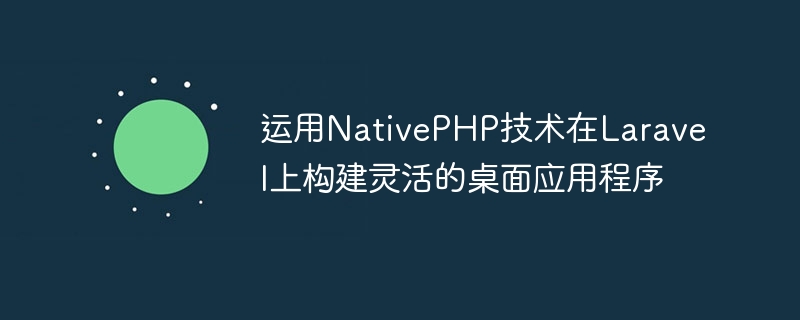Home >Backend Development >PHP Tutorial >Create flexible native PHP desktop applications using the Laravel platform
Create flexible native PHP desktop applications using the Laravel platform
- WBOYWBOYWBOYWBOYWBOYWBOYWBOYWBOYWBOYWBOYWBOYWBOYWBOriginal
- 2023-12-20 08:58:541947browse

Using NativePHP technology to build flexible desktop applications on Laravel requires specific code examples
With the continuous development of technology, the demand for desktop applications is also increasing more. However, developing desktop applications often requires the use of specific programming languages and frameworks. This article will introduce how to use NativePHP technology to build flexible desktop applications on Laravel and provide specific code examples.
First of all, we need to understand the concepts of NativePHP and Laravel.
NativePHP refers to writing desktop applications directly using the PHP language without using other languages or frameworks. Compared with traditional web development, NativePHP is more flexible and efficient and can meet the needs of complex desktop applications.
Laravel is a popular PHP framework with powerful features and rich ecosystem. It provides many convenient features and libraries to help developers build and manage PHP applications faster.
Next are the steps on how to build a desktop application on Laravel with corresponding code examples:
Step 1: Install the Laravel Framework
First, we need to install the Laravel Framework . Open a terminal or command prompt and run the following command:
composer global require laravel/installer
Step 2: Create Laravel Project
Run the following command to create a new Laravel project:
laravel new desktop-app
Step 3 :Install PHP-GTK extension
PHP-GTK is a GTK extension for PHP that can create desktop applications in a PHP environment. Run the following command in the terminal or command prompt to install the PHP-GTK extension:
sudo apt-get install php-gtk
Step 4: Create a desktop application window
Create a new window in the app directory of the Laravel project Class files, such as DesktopWindow.php. In this file, we can create a window for our desktop application using the PHP-GTK extension.
<?php
class DesktopWindow extends GtkWindow
{
public function __construct()
{
parent::__construct();
$this->set_title("Desktop App");
$this->set_size_request(400, 300);
}
}
Step 5: Using the desktop window
In the web.php file in the routes directory of the Laravel project, we can create a route to display the window of the desktop application.
Route::get('/desktop', function () {
$window = new DesktopWindow();
$window->show_all();
Gtk::main();
});
Step 6: Run the Desktop Application
In a terminal or command prompt, switch to the root directory of your Laravel project and run the following command:
php artisan serve
Open Browse server and access http://localhost:8000/desktop, you can see the desktop application window.
Through the above steps, we successfully built a flexible desktop application using NativePHP technology on Laravel. We used the PHP-GTK extension to create the desktop window and routed it through Laravel to display the window. This way, we can take advantage of Laravel to manage and scale our applications.
Summary
This article introduces how to use NativePHP technology to build flexible desktop applications on Laravel and provides detailed code examples. By combining NativePHP and Laravel, developers can more easily meet their desktop application needs. I hope readers can use the guidance of this article to further explore the potential of NativePHP and Laravel and apply them in actual projects.
The above is the detailed content of Create flexible native PHP desktop applications using the Laravel platform. For more information, please follow other related articles on the PHP Chinese website!

